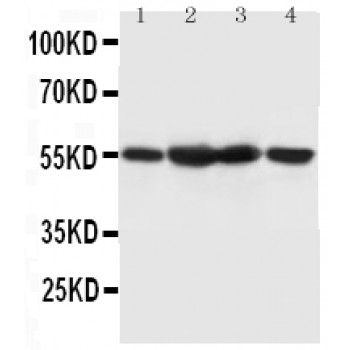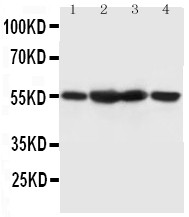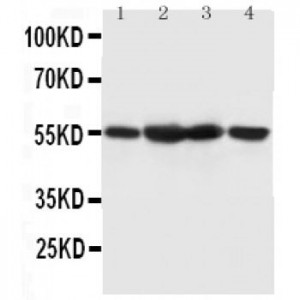More info
Overview
Long Name | Antibody Type | Antibody Isotype | Host | Species Reactivity | Validated Applications | Purification |
| histone deacetylase 1 | Polyclonal | IgG | Rabbit | Human, Mouse, Rat | WB | Immunogen affinity purified. |
Immunogen | ||||||
| A synthetic peptide corresponding to a sequence at the N-terminus of human HDAC1(1-14aa MAQTQGTRRKVCYY), identical to the related mouse and rat sequences. | ||||||
Properties
Form | Lyophilized |
Size | 100 µg/vial |
Contents | Antibody is lyophilized with 5 mg BSA, 0.9 mg NaCl, 0.2 mg Na2HPO4, 0.05 mg Thimerosal and 0.05 mg NaN3. *carrier free antibody available upon request. |
Concentration | Reconstitute with 0.2 mL sterile dH2O (500 µg/ml final concentration). |
Storage | At -20 °C for 12 months, as supplied. Store reconstituted antibody at 2-8 °C for one month. For long-term storage, aliquot and store at -20 °C. Avoid repeated freezing and thawing. |
Additional Information Regarding the Antigen
Gene | HDAC1 |
Protein | Histone deacetylase 1(HD1) |
Uniprot ID | Q13547 |
Function | Responsible for the deacetylation of lysine residues on the N-terminal part of the core histones (H2A, H2B, H3 and H4). Histone deacetylation gives a tag for epigenetic repression and plays an important role in transcriptional regulation, cell cycle progression and developmental events. Histone deacetylases act via the formation of large multiprotein complexes. Deacetylates SP proteins, SP1 and SP3, and regulates their function. Component of the BRG1-RB1-HDAC1 complex, which negatively regulates the CREST- mediated transcription in resting neurons. Upon calcium stimulation, HDAC1 is released from the complex and CREBBP is recruited, which facilitates transcriptional activation. Deacetylates TSHZ3 and regulates its transcriptional repressor activity. Deacetylates 'Lys-310' in RELA and thereby inhibits the transcriptional activity of NF-kappa-B. Deacetylates NR1D2 and abrogates the effect of KAT5-mediated relieving of NR1D2 transcription repression activity. Component of a RCOR/GFI/KDM1A/HDAC complex that suppresses, via histone deacetylase (HDAC) recruitment, a number of genes implicated in multilineage blood cell development. Involved in CIART-mediated transcriptional repression of the circadian transcriptional activator: CLOCK-ARNTL/BMAL1 heterodimer. Required for the transcriptional repression of circadian target genes, such as PER1, mediated by the large PER complex or CRY1 through histone deacetylation. |
Tissue Specificity | Ubiquitous, with higher levels in heart, pancreas and testis, and lower levels in kidney and brain. |
Sub-cellular localization | Nucleus. |
Sequence Similarities | |
Aliases | DKFZp686H12203 antibody|GON 10 antibody|HD 1 antibody|HD1 antibody|HDAC 1 antibody|HDAC1 antibody|hdac1: histone deacetylase 1 antibody|HDAC1_HUMAN antibody|Histone deacetylase 1(HD1) antibody|Histone deacetylase 1 antibody|Reduced potassium dependency yeast homolog like 1 antibody|RPD3(reduced potassium dependency yeast homolog) like 1 antibody|RPD3(reduced potassium dependency) antibody|RPD3 antibody|RPD3L1 antibody |
Application Details
| Application | Concentration* | Species | Validated Using** |
| Western blot | 0.1-0.5μg/ml | Human, Rat Mouse | AssaySolutio's ECL kit |
AssaySolution recommends Rabbit Chemiluminescent WB Detection Kit (AKIT001B) for Western blot. *Blocking peptide can be purchased at $65. Contact us for more information

Anti-HDAC1 antibody, ASA-B0839, Western blotting
Lane 1: MM453 Cell Lysate
Lane 2: MCF-7 Cell Lysate
Lane 3: HELA Cell Lysate
Lane 4: SMMC Cell Lysate
Lane 1: MM453 Cell Lysate
Lane 2: MCF-7 Cell Lysate
Lane 3: HELA Cell Lysate
Lane 4: SMMC Cell Lysate



